We have had hints of fall, especially when the remnants of Hurricane Irma passed through. Irma was only a ghost of herself that brought welcome relief from the heat and lots of rain to us, but fortunately not much wind. Soon summer's heat and humidity was back. But summer may truly be winding down now, with more moderate temps returning this weekend and into next week. I am so eager to get back into the garden! Lycoris radiata, or Spider Lily, is blooming now.
Lycoris radiata, or Spider Lily, is blooming now.
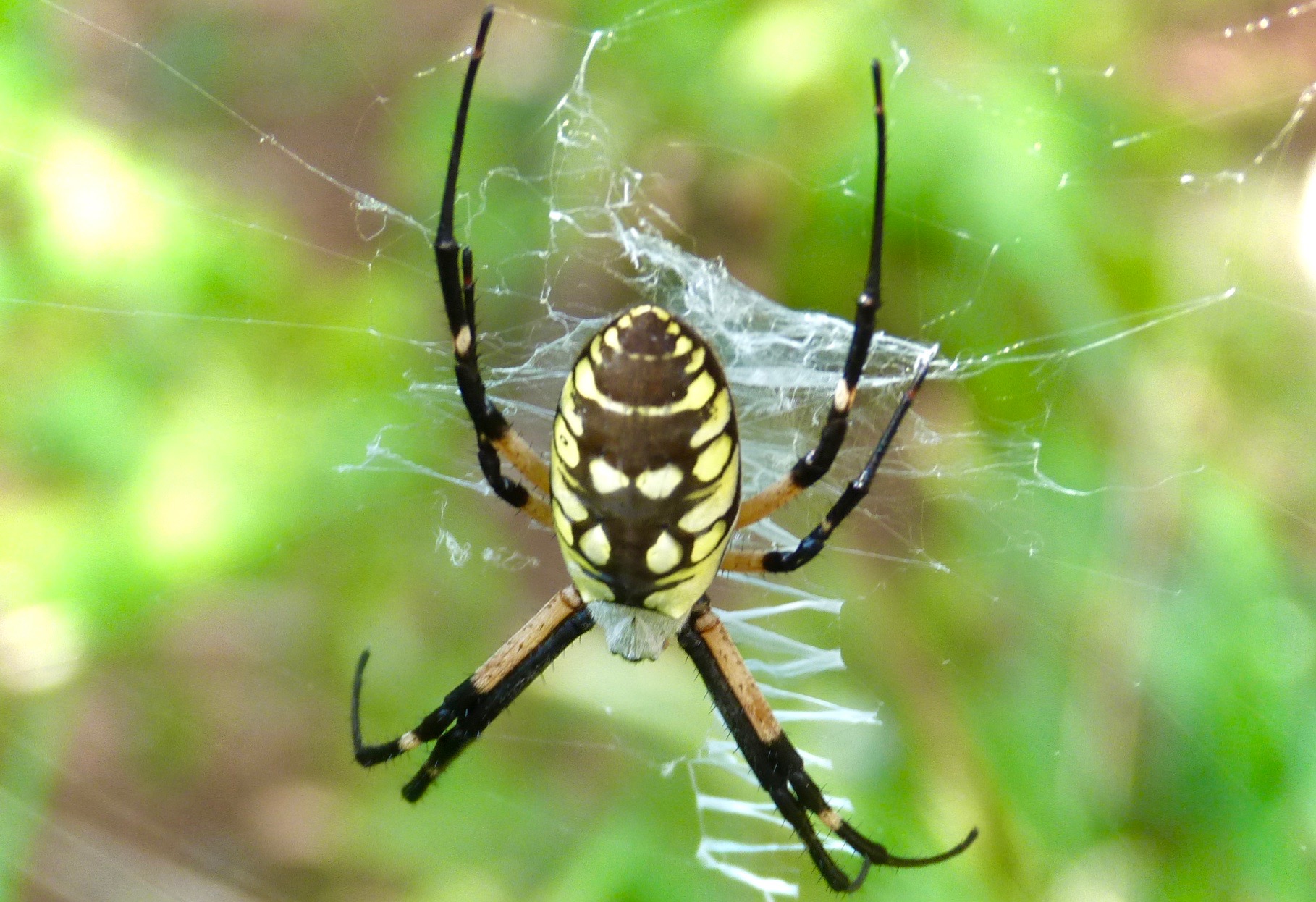 Speaking of spiders, it is spider season! All those spiders making webs are hungry females. Spiders are definitely good guys in the garden. This one is a black and yellow Argiope Orb Weaver.
Speaking of spiders, it is spider season! All those spiders making webs are hungry females. Spiders are definitely good guys in the garden. This one is a black and yellow Argiope Orb Weaver.
I have a host of chores awaiting me: Weeding, of course! We have had a wet summer, and the weeds have loved every bit of it. My longstanding habit is to weed as I go. I usually yank a few weeds, no matter what my purpose in the garden.  A current view of a section of the front garden.
A current view of a section of the front garden.
 This image is taken of the front garden near the patio. Lots of green right now!A handful of pulled weeds will prevent a thousand obnoxious offspring. Nevertheless, with a garden as large as mine, I dedicate some days to heavy-duty weeding, and a few hours of serious work will yield large lawn bags packed with weeds and a much neater garden.
This image is taken of the front garden near the patio. Lots of green right now!A handful of pulled weeds will prevent a thousand obnoxious offspring. Nevertheless, with a garden as large as mine, I dedicate some days to heavy-duty weeding, and a few hours of serious work will yield large lawn bags packed with weeds and a much neater garden.
Planting and transplanting. Here in the Deep South, fall is the perfect time to assess the garden and to plant new additions. Our ground does not freeze in the winter as it often does in colder regions, so roots have plenty of time to establish themselves before next year's summer heat. I like to put in transplants of lettuce, collards, Swiss chard, and other winter veggies now, too.
I also do a lot of transplanting of plants already in the garden. I am never afraid to move plants that are not happy in their locations. I confess I don't always get it right. I have moved some plants three or four times before finding the right place, or else the poor plants finally died in exasperation. All of these plants have been transplanted at least once. Clockwise top to bottom right: Aspidistra or Cast Iron plant, Hosta 'Blue Angel,' Pyrosia lingua or Japanese Felt Fern.
All of these plants have been transplanted at least once. Clockwise top to bottom right: Aspidistra or Cast Iron plant, Hosta 'Blue Angel,' Pyrosia lingua or Japanese Felt Fern.
Pruning. This needs to be done very soon. A few evergreens in my garden need a trim, but not after the first week of October. Beyond that and new growth may not have a chance to harden off before frost hits. One should prune at least six weeks to a month before the average frost date in your area. Here, we usually have our first frost around mid-November.
This is not the time to prune any spring flowering plants, as you would be cutting off next year's flower buds. Those plants should be pruned immediately after flowering next spring. Summer flowering shrubs should be pruned when they are dormant, in late winter or right before bud break in earliest spring.
Raking and clean-up. We may as well love this, as we have lots of trees and lots of fall leaves! It is a great form of exercise. Most important for me is to keep my moss paths clear of leaves and debris, as moss needs air to succeed. Peacock moss, or Selaginella uncinata, and Lady Fern, or Athirium, grow next to my moss path in the woodland garden.
Peacock moss, or Selaginella uncinata, and Lady Fern, or Athirium, grow next to my moss path in the woodland garden.
 A side path in the woodland garden. The pink and green bromeliads are not hardy and will come inside for the winter, as will the variegated fig on the left in the top image. The colorful New Guinea Impatiens are annuals that will need to be replaced next year.
A side path in the woodland garden. The pink and green bromeliads are not hardy and will come inside for the winter, as will the variegated fig on the left in the top image. The colorful New Guinea Impatiens are annuals that will need to be replaced next year.
Bring in my Tropicals. I brighten areas of the garden through spring and summer with potted plants that are not hardy. These all come inside once the temps drop into the fifties. My husband's office turns into a greenhouse.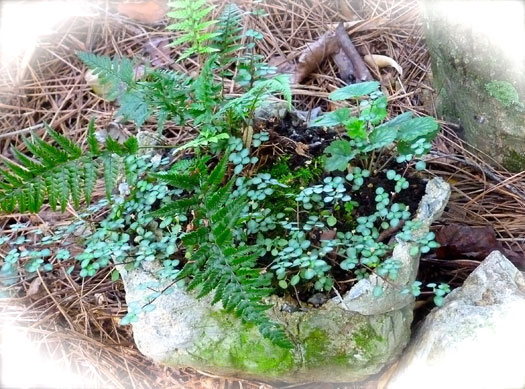 This little dish garden contains Pilea, a non-hardy plant, and a small fern.
This little dish garden contains Pilea, a non-hardy plant, and a small fern.
I am looking forward to all the above chores. I am dreaming of cool, fresh air and all the wonderful fall colors. Happy autumn!
 Sunday, November 19, 2017 at 8:40PM
Sunday, November 19, 2017 at 8:40PM 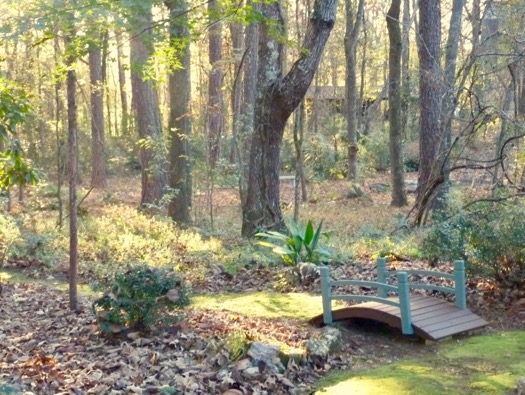



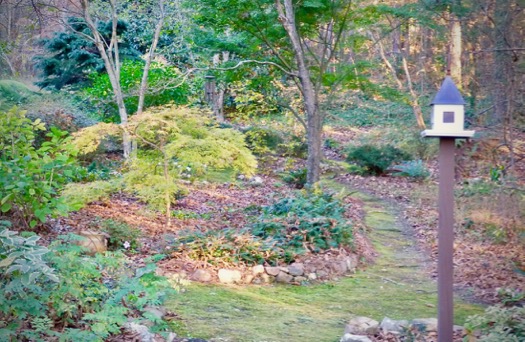
 Japanese maple 'Waterfall'
Japanese maple 'Waterfall' Clockwise from top left: Persimmon 'Tamopan'; Mahonia 'Soft Caress'; Camellia 'Leslie Ann'; Witch Hazel - I planted this years ago, and it has finally bloomed!
Clockwise from top left: Persimmon 'Tamopan'; Mahonia 'Soft Caress'; Camellia 'Leslie Ann'; Witch Hazel - I planted this years ago, and it has finally bloomed!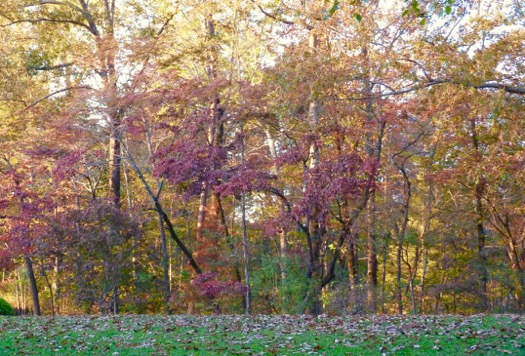
 November,
November,  fall garden,
fall garden,  moss path,
moss path,  woodland garden in
woodland garden in  clouds and sky,
clouds and sky,  fall,
fall,  fall garden,
fall garden,  woodland garden
woodland garden 







